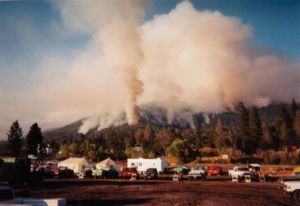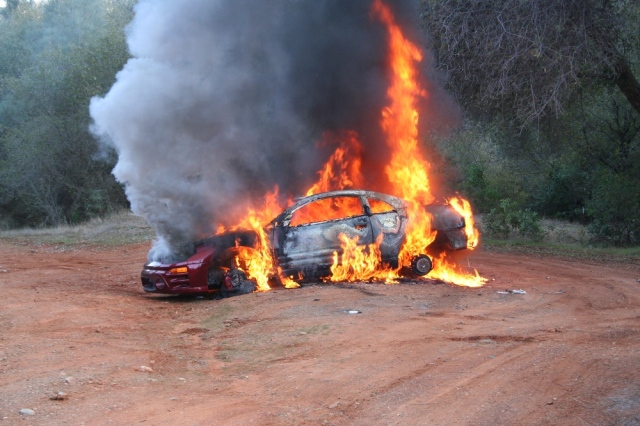Fire cautions in the Sierra Foothills
We took this photo up on the hill above our house, in the California Sierra foothills on Tuesday. There is still fire danger out there and you can see the burned trees from 12 years ago. This smoke above was from a stolen car set on fire.
Fire slowly spread through our property in August 2001 before we started to build, effectively ‘brushing it out’ without going too far up in the trees, thank goodness! One mile up the road was devastated as the fire built strength.
Since moving here 6 years ago and really from the time we first bought the property in November 2000, we have become more and more aware of the danger of fire in the forest community.
In 2007, we spotted a black plume of smoke off the road near Coulterville, Ca. As we turned off to investigate, we saw another stolen car fire and left immediately realizing that the perpetrators could still be nearby. No cell service in the area, but we drove to the nearest telephone and the fire fighters had the fire under control within the hour.
Realities
The sobering fact is that our home and property, at the end of a 600 foot driveway, with no other exit and barely enough room for a fire truck to turn around, is one to which no fire chief would send his men. A fire battalion chief friend, Ed, said, “The best precaution for you two, will be darn good home insurance.” We got it. We also know that in case of fire, our firemen friends would do all in their power to help us.
Our plan
Besides getting good insurance, we have learned skills that reduce our fire danger here:
- Clearing trees and shrubs close to the house.
- Trimming trees ten foot around and ten feet up into the branches.
- Mowing 100 feet around the house.
- Keeping the garden vegetation watered and hydrated a much as possible during the summer and fall.
- Keep premium, 100 foot, 1 inch diameter hoses near faucets on both sides of the property closest to the house.
- If you have a well, install a 2500 gallon water storage tank with a fire hose connection.
- Plant plants that are fire resistant. Is there such?
Poppies pop up on this old burn pile. later a bullldozer buzzed through these to widen and reroute the driveway.
How to do Burn piles
Practicing burn pile safety was another skill taught to us by Ed, our fire battalion chief friend, who supervised our first few fires. Burn piles are a reality when maintaining land near the forest as an alternative to hauling and dumping tree trimmings and brush into landfills.
We had three or four oak trees that had to be felled to prepare the house pad in 2003. With no fireplace to burn even small logs, we had huge piles of branches that had to be cleared. We stacked what firewood we could and burned the piles of branches on cold or misty days when the ashes would fall to the ground quickly.
In our county, you obtain a burn permit and call a number each time to see if it is a ‘burn day’, one with little fire danger. We have this number on speed dial. Usually a burn day is a drizzly day or the days just before or after a rain. On these days you can see spot fires all through the Oakhurst Valley below Deadwood Peakand know that many are busy brushing out their properties.
Equipment needed are rakes, a hose nearby and a gas can and lighter. With good size fires you need one person to start and feed the flame and one to watch for sparks and grass fires with the hose. Our largest fires have been ones about the size of a car. Tractor Man comes out and compacts and pushes together the brush piles first, if possible. We’ve learned not to set cast off flannel shirts too close to the fire after having picked up one or two only to find it burned with a myriad of black singed holes.
Uses for burn piles in the garden
Brush piles burn fast and hot. You make sure to site your fire 10 feet out from the crown of any tree, ideally in a wide open area. You burn pretty close to where you’re working, though, and as you move from area to area, you learn to drag branches down to your fire not up!
It all over soon and we keep watch over the smoldering grey ash under it stops smoking. Locals don’t always do this and it’s unnerving to spot unattended burn piles, still smoking though only inches high. We tend to use the same spot over and over.
After the fire has cooled and left blackened ground, there are uses for the garden. Old burn piles can be planted with wildflowers. This is one of a few photos taken after the 2001, showing the brown, burned manzanita, charred oak tree trunks and the grizzled mountain beyond. Green grass popped up after Fall rains and the neighbors commented slyly that we’d have little brushing to do this year.
If you dig down under the singed earth of an old burn pile, you find crumbly loam similar to potting soil and can be used for just that purpose! This I read about in a book written by a old woman, (a young gardener…) who advised that all her potted plants grew unbelievably well in this soil. I dig for this ‘potting soil’ beneath old burn piles, and it works well to balance my low acid native soil in all my patio pots.
Aftermath of the August 2001 fire
The man who accidentally set this fire across the road from us by using a gas powered tool,, had two million dollar policies on his house. To defray the costs of fighting what was called the North Fork Fire, the state of California collected the full amount on both.
Recent Posts
How to Be a Lazy Gardener
...and still have a pretty garden With a busy household and jobs, we are…
Summer is Spring at Whiskey Falls!
Take a day trip to Whiskey Falls... Come visit Whiskey Falls and the surrounding high…
California oak acorns: Feast or famine
Why do oaks drop more acorns some years and not others? If you have live…
Mule’s ear and Farewell to Spring
Roadside treasures worth stopping for In the first week of July in the Sierra foothills…
Our favorite butterfly plants
Wow! Butterflies love these plants! Grow any of these for instant results and each is…
A water-saving veggie garden for the foothills
Your water-wise veggie garden Does everyone in our Mountain Community grow at least one tomato?…



